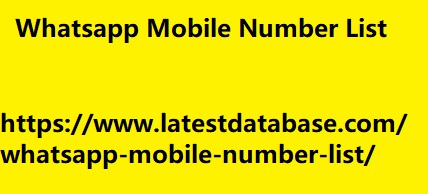Post by account_disabled on Jan 11, 2024 8:34:05 GMT
– Plug your target keywords or the topics you blog about into Google Blog Search to discover your fellow niche-related bloggers
Technorati – Use Technorati to identify the “Top X Blogs” online, rated by Technorati Authority, which measures a site’s “standing and influence in the blogosphere”
Google Alerts – A more passive option is to set up real time alerts through Google Alerts so you can monitor specific keywords that sites and bloggers would use that are closely-related to your niche
“Best of” Lists – The Web is saturated with compilation lists of the “Best X Blogs,” which can help give you an idea of respected blogs/bloggers in your area of interest. For example, I had a client who runs a “cycling blog.” When researching for influencers, I found a great collection of the “Top 50 Cycling Blogs” which is ranked using metrics like traffic and social media Whatsapp Mobile Number List presence. In any case, lists like this are a great place to identify and explore bloggers to target.
After you’ve found a list of influential blogger prospects, you should create a spreadsheet to manage all the information. I like to organize the info into columns like “contact info,” “twitter handle,” “outreach efforts,” “blog name” and “URL,” “outcome,” etc.

Inbound Links: It’s safe to assume that “good content attracts links,” so the more links a blog or blog post earns, the more engaging or popular it is. There are a number of link data sources you can use (both free and paid). Some of my favorites include Yahoo Site Explorer, Open Site Explorer, Majestic SEO, Influence Finder or SEO Spyglass (read my review here). I’ve also written about how you can analyze the SERPs to find the most popular and most linked blog posts in a niche.
Social Engagement: Check out the blog’s Twitter activity, Facebook “like” totals, Digg and Reddit activity, etc. BTW, If you’re interested in plunking down some cash to get these metrics, PostRank offers a slick data service that tracks social engagement across 20 different social hubs through their API.
Alexa Rank: Alexa ranks sites with an algorithm that incorporates page views and reach. It’s not a precise measurement on its own, but it’s a good metric when used on a relative scale and comparing one blog to another.
Community Engagement: I also like to see blogs that have an active and engaged audience that comments often and frequently.
Again, add these metrics to columns in your Excel spreadsheet and give yourself even more data points to evaluate potential blogs and bloggers to connect with.
Technorati – Use Technorati to identify the “Top X Blogs” online, rated by Technorati Authority, which measures a site’s “standing and influence in the blogosphere”
Google Alerts – A more passive option is to set up real time alerts through Google Alerts so you can monitor specific keywords that sites and bloggers would use that are closely-related to your niche
“Best of” Lists – The Web is saturated with compilation lists of the “Best X Blogs,” which can help give you an idea of respected blogs/bloggers in your area of interest. For example, I had a client who runs a “cycling blog.” When researching for influencers, I found a great collection of the “Top 50 Cycling Blogs” which is ranked using metrics like traffic and social media Whatsapp Mobile Number List presence. In any case, lists like this are a great place to identify and explore bloggers to target.
After you’ve found a list of influential blogger prospects, you should create a spreadsheet to manage all the information. I like to organize the info into columns like “contact info,” “twitter handle,” “outreach efforts,” “blog name” and “URL,” “outcome,” etc.
Inbound Links: It’s safe to assume that “good content attracts links,” so the more links a blog or blog post earns, the more engaging or popular it is. There are a number of link data sources you can use (both free and paid). Some of my favorites include Yahoo Site Explorer, Open Site Explorer, Majestic SEO, Influence Finder or SEO Spyglass (read my review here). I’ve also written about how you can analyze the SERPs to find the most popular and most linked blog posts in a niche.
Social Engagement: Check out the blog’s Twitter activity, Facebook “like” totals, Digg and Reddit activity, etc. BTW, If you’re interested in plunking down some cash to get these metrics, PostRank offers a slick data service that tracks social engagement across 20 different social hubs through their API.
Alexa Rank: Alexa ranks sites with an algorithm that incorporates page views and reach. It’s not a precise measurement on its own, but it’s a good metric when used on a relative scale and comparing one blog to another.
Community Engagement: I also like to see blogs that have an active and engaged audience that comments often and frequently.
Again, add these metrics to columns in your Excel spreadsheet and give yourself even more data points to evaluate potential blogs and bloggers to connect with.
